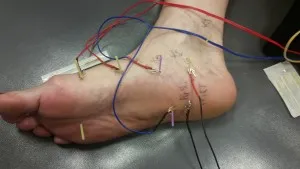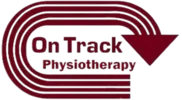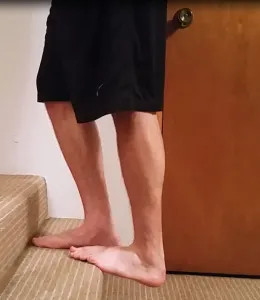Plantar Fasciitis (Ann Arbor, Mi) – Anybody who has ever experienced plantar fasciitis before knows that it can be a very frustrating process. Heel pain impacts just about every daily activity that involves standing or walking. Maybe your pain is not quite as bad, but it has prevented you from running or working out as you love to do so much. It is estimated that approximately 1 million patient visits per year are due to plantar fasciitis. It is also estimated that it may account for 8% of running injuries
(The point of this video was not to confuse you. This article is geared towards a more conventional approach to treating plantar fascia. However, I do hope this video opened your eyes a little that there are many more factors influencing plantar fasciitis that you may have never considered before.)
Plantar fasciitis refers to a strain in the muscle tissue on the bottom of the foot. Often times the area that becomes strained is on the inside portion of the heel. This is the area where most of the pain occurs and can often be very sensitive to pressure, touch, or weight-bearing. What causes this painful experience to occur?
Generally, it comes down to three things:
1) A sudden increase in activity that your body was not prepared to handle.
2) A lack of variability in movement.
3) An accumulation of repetitive physical stress without ample rest.
However, once you have reached the tipping point and pain has occurred, your body will start to heal itself naturally through a very normal process called inflammation.
Yes, you read that right! A very beneficial and normal process called inflammation. The inflammation process is needed for the body’s natural healing process to start. Insulin growth factor is brought to the injured area for new collagen to lay down and build tensile strength back up.
If you never addressed the three causation factors described above, or never did anything to help influence the inflammation, repair, and remodel phases the body naturally goes through; then chances are the pain will linger on longer than normal.
Maybe you have experienced plantar fasciitis for quite some time now, and had an x-ray performed. Upon results of the x-ray, you may have been told that you have a “heel spur.” If you get one thing out of this article, please do not be intimidated or frightened by a “heel spur.” It’s not like what it sounds. I will use quotations around “spur” because you will not hear me say this word.
Understand that a “spur” most likely develops due to a failed healing response. The inflammatory response probably was triggered from one of the three causation factors listed previously. Again, inflammation is good because it will start the healing process. However, if then never allowed or influenced to both repair and remodel, the cycle may restart all over again as the body tries to autocorrect. Multiple restarts during this process can lead to an excessive buildup of osteophyte formation. This excessive buildup can start to form what would be considered a “spur”, but don’t get too anxious on me! Research has shown that this doesn’t necessarily always correlate with plantar fasciitis. A study by Cornwall & McPoil, reviewed x-rays of 1,000 patients and found only 13.2% had heel “spurs”. Of these, only 39% reported heel pain. Yes, you read that right. Less than 50% of “spurs” caused pain.
So what can we do about all this?
The recovery process can be slow at times. Resolution for a case of true plantar fasciitis has been reported as long as 6-18 months in some cases. This can become increasingly frustrating when each waking morning you take the first few painful steps. Chances are you have been told that you need better shoes and have to perform a series of stretches religiously throughout the day.
While both are great suggestions and often provide some, if not complete relief in the long term, the short-term results tend to be less than desirable.
High load strength training to the plantar fascia appears to be beneficial as well.
Self-myofascial release also gets a lot of publicity to treat plantar fasciitis. Maybe you have been told to roll a tennis ball or lacrosse ball on the arch of your foot.
This method can be effective, but not for the reasons you may have been told. Contrary to popular belief, you are not elongating the plantar fascia or breaking up scar tissue. Research has shown that it takes 460kg of force to increase the plantar fascia length by 1%6.
I doubt someone’s thumb or a lacrosse ball is going to create this amount of force. Rather, there is probably a neurological mechanism that occurs which temporarily reduces tone/guarding in the musculature.
While the research definitely supports these methods to reduce pain, it still can be a time consuming process. Furthermore, all these strategies can be implemented without a healthcare provider. This is where On Track PT and Performance is different. We know you can perform these methods in the convenience of your home, so we don’t expect you to come in 3x per week and watch you perform exercises that you are already doing at home. We treat patients 1x per week, every other week, or in some rare cases 2x per week. For treatment, we focus on highly trained techniques with research that has shown to decrease recovery time.
Less therapy visits and a potentially faster recovery time! Sound interesting?
Instrumented Assisted Soft Tissue Mobilization (IASTM)
Again, the chances we are actually deforming fascia are slim here, as mentioned in the research above. If a clinician thinks they need to perform this technique aggressively and cause an excessive amount of discomfort to get results, they should reconsider why they have chosen this treatment modality. Rather, what is probably happening via mechanical stimulus is increasing blood flow, temporarily reducing tone, and influencing cellular mediators to start remodeling tissue in a more resilient way. With all these benefits, it is understandable why this, in conjunction with stretching/strengthening, has been shown through research to possibly speed recovery times.
Dry Needling to the Plantar Fascia

Admittedly, this treatment is not for everyone. Everyone always asks how painful it is? I will start by saying that anywhere I use dry needling; I have personally had it done on myself. So from personal and anecdotal experience, I can say that in some areas dry needling is actually very comfortable. However, the plantar fascia tends to be one of the areas where there are some sore points that elicit a “deep ache” or a “bee sting.”
Physiologically, it has a much greater physiological and neurological effect than IASTM. This is due to the increased stimulation that occurs when a needle penetrates the skin. Even more stimulation occurs when therapeutic electrical stimulation is then hooked up. Dry needling in conjunction with electrical stimulation has been shown to have an inhibitory effect on pain through opioid release. These effects can potentially lead to much better short term results.

About the Author: Dr. Greg Schaible is a physical therapist and strength coach specializing in athletic performance. He attended The University of Findlay as a student athlete. As an athlete he competed in both Indoor and Outdoor Track & Field where he earned honors as a 5x Division II All-American and 6x Division II Academic All-American. In 2013 he completed Graduate School earning his Doctorate of Physical Therapy (DPT). Greg is the owner of On Track Physical Therapy in Ann Arbor, Mi. Follow On Track PT and Performance on Facebook.
References
Riddle DL, Pulisic M, Pidcoe P, Johnson RE. Risk factors for Plantar fasciitis: a matched case-control study.J Bone Joint Surg Am. 2003 May. 85-A(5):872-7.
Lysholm J, Wiklander J. Injuries in runners. Am J Sports Med 1987;15(2):168-71
Cornwall, Mark W., and Thomas G. McPoil. “Plantar fasciitis: etiology and treatment.” Journal of Orthopaedic & Sports Physical Therapy 29.12 (1999): 756-760.
Fasciitis, Plantar. “Plantar fasciitis: diagnosis and therapeutic considerations.”Alternative Medicine Review 10.2 (2005): 83-93.
DiGiovanni, Benedict F., et al. “Tissue-specific plantar fascia-stretching exercise enhances outcomes in patients with chronic heel pain.” The Journal of Bone & Joint Surgery 85.7 (2003): 1270-1277.
Rathleff, M. S., et al. “High‐load strength training improves outcome in patients with plantar fasciitis: A randomized controlled trial with 12‐month follow‐up.”Scandinavian journal of medicine & science in sports (2014).
Chaudhry, Hans, et al. “Three-dimensional mathematical model for deformation of human fasciae in manual therapy.” The Journal of the American Osteopathic Association 108.8 (2008): 379-390.
Looney B et al. Graston instrument soft tissue mobilization and home stretching for the management of plantar heel pain: a case series. JMPT. 2011;34(2):138-142.
Cagnie, Barbara, et al. “Physiologic effects of dry needling.” Current pain and headache reports 17.8 (2013): 1-8.
Tillu, A., and S. Gupta. “Effect of acupuncture treatment on heel pain due to plantar fasciitis.” Acupuncture in Medicine 16.2 (1998): 66-68.






